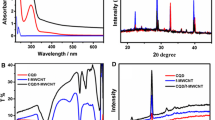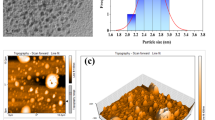Abstract
In this paper, a novel synthesis of 1 nm sized metal-free carbon quantum dots (CQDs) and their electrochemical application vis-à-vis mercury (Hg) sensing have been demonstrated. The characterization of synthesized CQDs was done by FT-IR, HR-TEM, XRD and UV–Vis analysis. Furthermore, the CQD-modified electrode shows an excellent sensing ability toward deleterious Hg ion even when 600-fold of excess of interfering ions such as Cu2+, Pb2+, Cd2+, Na+, K+, Mg2+, Ba2+, Bi2+, Fe2+, Zn2+ and Hg2+ are present. A wide linearity range (0.5–300 nM) and the lowest limit of detection (2.5 nM) are exhibited by the proposed sensor with potential scanning from − 0.7 to + 0.7 V vs Ag/AgCl at a scan rate of 20 mV. In addition, the CQD-modified electrode displays an outstanding recovery results toward Hg in various real water samples. This study promotes new possibilities of designing various electrochemical sensors based on CQD nanocomposite.
ArticleHighlights
-
Fast detection of mercury ion by electrochemical method.
-
One-pot synthesis of CQDs from activated carbon obtained from coconut shell.
-
Both selective and sensitive nature of CQD-modified electrode.
-
Anti-interference ability, stability, and reproducibility of the CQD-modified electrode are highly good.






Similar content being viewed by others
References
Anju M, Divya T, Nikhila MP, Kusumam TVA, Akhila AK, Ansi VA, Renuka NK (2016) Nano-surface energy transfer based highly selective and ultrasensitive “turn on” fluorescence Hg sensor. RSC Adv 6:109506–109513
Badiei A, Razavi BV, Goldooz H, Ziarani GM, Faridbod F, Ganjali MR (2018) A novel fluorescent chemosensor assembled with 2,6-bis(2-benzimidazolyl)pyridine functionalized nanoporous silica-type SBA-15 for recognition of Hg2+ ion in aqueous media. Int J Environ Res 12:109–115
Bojdi MK, Behbahani M, Omidi F, Hesam G (2016) Application of a novel electrochemical sensor based on modified siliceous mesocellular foam for electrochemical detection of ultra-trace amounts of mercury ions. New J Chem 40:4519–4527
Chen L, Li J, Chen L (2015) Colorimetric detection of mercury species based on functionalized gold nanoparticles. ACS Appl Mater 5:445–451
Chen N, Zhang Y, Liu H, Wu X, Li Y, Miao L, Shen Z, Wu A (2016) High-performance colorimetric detection of Hg based on triangular silver nanoprisms. ACS Sens 1:521–527
Daud N, Yusof N, Tee T (2011) Development of electrochemical sensor for detection of mercury by exploiting His–Phe–His–Ala–His–Phe–Ala–he modified electrode. Int J Electrochem Sci 6:2798–2807
Ding X, Kong L-T, Wang J, Fang F, Li D, Liu J (2013) Highly sensitive SERS setection of Hg2+ ions in aqueous media using gold nanoparticles/graphene heterojunctions. ACS Appl Mater Interfaces 5:7072–7078
Dong Y, Zhou N, Lin X, Jianpeng L, Chi Y, Chen G (2010) Extraction of electrochemiluminescent oxidized carbon quantum dots from activated carbon. Chem Mater 22:5895–5899
Enaime G, Ennaciri K, Ounas A, Baçaoui A, Seffen M, Selmi T, Yaacoubi A (2017) Preparation and characterization of activated carbons from olive wastes by physical and chemical activation: application to Indigo carmine adsorption. J Mater Environ Sci 8:4125–4137
Gawande PR, Dr KJ (2017) Characterization and activation of coconut shell activated carbon Research Paper. Int J Eng Sci Invent 6:43–49
Gogoi S, Kumar M, Mandalb BB, Karak N (2016) A renewable resource based carbon dot decorated hydroxyapatite nanohybrid and its fabrication with waterborne hyperbranched polyurethane for bone tissue engineering. RSC Adv 6:26066–26076
Gras R, Luong J, Shellie RA (2015) Direct measurement of trace elemental mercury in hydrocarbon matrices by gas chromatography with ultraviolet photometric detection. Anal Chem 87:11429–11432
Huang J, Bai S, Yue G, Cheng W, Wang L (2017) Coordination matrix/signal amplifier strategy for simultaneous electrochemical determination of cadmium(II), lead(II), copper(II), and mercury(II) ions based on polyfurfural film/multi-walled carbon nanotube modified electrode. RSC Adv 7:28556–28563
Ichinoki S, Kodani M, Fujii Y (2009) Selective and sensitive determination of mercury (II) ions in river water by an automatic HPLC system combined with on-line column enrichment as 2-mercaptopyrimidine chelate. J Liq Chromatogr Relat Technol 32:1463–1474
Ichinoki S, Kodani M, Fujii Y (2014) Selective determination of mercury (II) ion in water by solvent extraction followed by reversed-phase HPLC. J Liq Chromatogr Relat Technol 27:1785–1798
Jia X, Li J, Wang E (2012) One-pot green synthesis of optically pH-sensitive carbon dots with upconversion luminescence. Nanoscale 4:5572–5575
Kakaei K, Javan H, Mohammadi HB (2016) Synthesis of carbon quantum dots nanoparticles by cyclic voltammetry and its application as methanol tolerant oxygen reduction reaction electrocatalyst. J Chin Chem Soc 63:432–437
Kanchana P, Sudhan N, Anandhakumar S, Mathiyarasu J, Manisankar P, Sekar C (2015) Electrochemical detection of mercury using biosynthesized hydroxyapatite nanoparticles modified glassy carbon electrode without preconcentration. RSC Adv 5:68587–68594
Kumar VB, Borenstein A, Markovsky B, Aurbach D, Gedanken A, Talianker M, Porat Z (2016) Activated carbon modified with carbon nano-dots as novel electrode material for supercapacitors. J Phys Chem C 120:13406–13413
Liang Z, Kang M, Payne GF, Wang X, Sun R-C (2016) Probing energy and electron transfer mechanisms in fluorescence quenching of biomass carbon quantum dots. ACS Appl Mater Interfaces 8:17478–17488
Liu S-J, Nie H-G, Jiang J-H, Shen G-L, Yu R-Q (2009) Electrochemical sensor for Hg(II) based on conformational switch mediated by interstrand cooperative coordination. Anal Chem 81:5724–5730
Long SE, Kelly WR (2002) Determination of mercury in coal by isotope dilution cold-vapor generation inductively coupled plasma mass spectrometry. Anal Chem 74:1477–1483
Manganiello L, Rıos A, Valcarcel M (2002) A method for screening total mercury in water using a flow injection system with piezoelectric detection. Anal Chem 74:921–925
Matlou GG, Nkosi D, Pillay K, Arotiba O (2016) Electrochemical detection of Hg(II) in water using self-assembled single walled carbon nanotube-poly (m-amino benzene sulfonic acid) on gold electrode. Sens BioSens Res 10:27–33
Mora IC, Romero V, Lavilla I, Bendicho C (2014) In situ building of a nanoprobe based on fluorescent carbon dots for methylmercury detection. Anal Chem 86:4536–4543
Nguyen HV, Richtera L, Moulick A, Xhaxhiu K, Kudr J, Cernei N, Polanska H, Heger Z, Masarik M, Kopel P, Stiborova M, Eckschlager T, Adam V, Kizek R (2016) Electrochemical sensing of etoposide by using carbon quantum dots modified glassy carbon electrode. Analyst 141:2665–2675
Pan J, Sheng Y, Zhang J, Huang P, Zhang X, Feng B (2015) The photovoltaic conversion enhancement of c quantum dots/p-type CuAlO2/n-type ZnO photoelectric device. ACS Appl Mater Interfaces 7:7878–7883
Panta YM, Liu J, Cheney MA, Jood SW, Qian S (2009) Ultrasensitive detection of mercury (II) ions using electrochemical surface plasmon resonance with magneto hydrodynamic convection. J Colloid Interface Sci 333:485–490
Parvin N, Mandal TK (2016) Synthesis of highly fluorescence nitrogen doped carbon quantum dots bioimaging probe, their in vivo clearance and printing applications. RSC Adv 6:18134–18140
Ponnaiah SK, Prakash P, Vellaichamy B (2018a) A new analytical device incorporating a nitrogen doped lanthanum metal oxide with reduced graphene oxide sheets for paracetamol sensing. Ultrason Sonochem 44:196–203
Ponnaiah SK, Periakaruppan P, Vellaichamy B, Paulmony T, Selvanathan R (2018b) Picomolar-level electrochemical detection of thiocyanate in the saliva samples of smokers and non-smokers of tobacco using carbon dots doped Fe3O4 nanocomposite embedded on g-C3N4 nanosheets. Electrochim Acta 283:914–921
Ratner N, Mandler D (2015) Electrochemical detection of low concentrations of Hg in water using gold nanoparticles. Anal Chem 87:5148–5155
Rex M, Hernandez FE, Campiglia AD (2006) Pushing the limits of mercury sensors with gold nanorods. Anal Chem 78:445–451
Sarkar PK, Polley N, Chakrabarti S, Lemmens P, Pal SK (2016) Nano-surface energy transfer based highly selective and ultrasensitive “turn on” fluorescence Hg sensor. ACS Sens 1:789–797
Sihombing E, Situmorang M, Sembiring T, Nasruddin N (2015) The development of mercury ion selective electrode with ionophore 7,16-Di-(2-Methylquinolyl)-1,4,10,13-Tetraoxa-7,16 Diazacyclooctad ecane (DQDC). Mod App Sci 9:81–90
Wang W, Wang Y, Tu L, Klein T, Feng Y, Li Q, Wang J-P (2014) Magnetic detection of mercuric ion using giant magnetoresistance-based biosensing system. Anal Chem 86:3712–3716
Wang L, Zhao Y, Tian Y (2015) Two-dimensional FeS nanoflakes: synthesis and application to electrochemical sensor for mercury (II) ions. J Nanopart Res 17:1–9
Wang N, Lin M, Dai H, Ma H (2016a) Functionalized gold nanoparticles/reduced graphene oxide nanocomposites for ultrasensitive electrochemical sensing of mercury ions based on thymine–mercury–thymine structure. Biosens Bioelectron 79:320–326
Wang P, Zhong R-B, Yuan M, Gong P, Zhao X-M, Zhang F (2016b) Mercury (II) detection by water-soluble photoluminescent ultra-small carbon dots synthesized from cherry tomatoes. Nucl Sci Tech 2:2210–3147
Yasri NG, Sundramoorthy AK, Chang WJ, Gunasekaran S (2014) Highly selective mercury detection at partially oxidized graphene/poly (3, 4 ethylenedioxythiophene): poly (styrenesulfonate) nanocomposite film-modified electrode. Front Mater 1:33
Zhang L, Chang H, Hirata A, Wu H, Xue Q-K, Chen M (2013a) Nanoporous gold based optical sensor for sub-ppt detection of mercury ions. ACS Nano Sci 7:4595–4600
Zhang Y, Zhao H, Wu Z, Xue Y, Zhang X, He Y, Li X, Yuan Z (2013b) A novel graphene-DNA biosensor for selective detection of mercury ions. Biosens Bioelectron 48:180–187
Zhang Y, Zeng G, Tang L, Chen J, Zhu Y, He X, He Y (2015) Electrochemical sensor based on electrodeposited graphene-Au modified electrode and nanoAu carrier amplified signal strategy for attomolar Hg detection. Anal Chem 87:989–996
Zhou G, Chang J, Pu H, Shi K, Mao S, Sui X, Ren R, Cui S, Chen J (2016) Ultrasensitive Hg ion detection using DNA-functionalized molybdenum disulfide nano sheet/gold nanoparticle hybrid field-effect transistor device. ACS Sens 1:295–302
Zhu Z, Su Y, Li J, Li D, Zhang J, Song S, Zhao Y, Li G, Fan C (2009) Highly sensitive electrochemical sensor for mercury (II) ions by using a hg-specific oligonucleotide probe and gold nanoparticle-based amplification. Anal Chem 81:7660–7666
Author information
Authors and Affiliations
Corresponding author
Ethics declarations
Conflict of interest
The authors declare that they have no competing financial interest.
Rights and permissions
About this article
Cite this article
Barvin, R.K.B., Prakash, P., Ganesh, V. et al. Highly Selective and Sensitive Sensing of Toxic Mercury Ions Utilizing Carbon Quantum Dot-Modified Glassy Carbon Electrode . Int J Environ Res 13, 1015–1023 (2019). https://doi.org/10.1007/s41742-019-00236-2
Received:
Revised:
Accepted:
Published:
Issue Date:
DOI: https://doi.org/10.1007/s41742-019-00236-2




